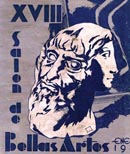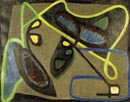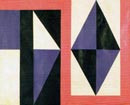The painter we’re presenting now is an old reference in my archives, despite the fact that the international press and the art market ballyhooed in 2009 the “sensational discovery” of Carmen Herrera.
I opened her file in 1975. It was a small scrap from ArtNews, an American art magazine, that announced the grand opening of the artist’s exhibit at the South American Gallery in New York back in 1956. Thanks to my insistence, some friends sent me catalogs, scraps, pictures and so I pieced together a not-so-large compilation that managed to depict the different aspects of Carmen Herrera’s artistic activity in New York, where she’s lived since 1939.
But surprises started popping up as I delved deeper into the file. Her name was in the catalog of the First Modern Art Exhibition held in the halls of the Centro de Dependientes, in Havana. However, she was not the painter at that time, but the sculptor of a “Christ” carved in mahogany. To top it all off, we also found out that a few days earlier she has taken part in the First Exposition of Outdoor Painting and Sculpturing at the Albear Park. Quite coincidentally, the text in the catalog written by Jose Antonio Portuondo, shows the first mention ever made about her work: “thorough search in Carmen Herrera’s carvings”. We could even turn back time a tad further, to 1933 and found her name in what appears to be her first public presentation in the Self-Portrait Exposition organized by the Havana Fine Arts Circle. Later on we discovered that at that time Carmen was studying architecture in the University of Havana, a course she dropped out of after her freshman year.
It’s not easy at all to track down the artist’s itinerary from that moment on. She studied in Paris during the postwar period and returned to New York in 1953. Curiously enough, she staged her first individual exhibit at the Lyceum in 1950 during one her visits to the island. Never again she exhibited in Cuba and hardly ever did it in the Big Apple. As she has put it, painting was a need for her, so she decided to ignore all the art fanfare for decades, regardless of the fact that her small-scale artworks could rub elbows with the likes of Kelly or Newman, let alone other names that were gone with the wind.
When in 1993 the team of authors working on the project entitled Memory: Cuba’s 20th Century Visual Arts embarked on the task to gather information for the book, we didn’t hesitate to pick Carmen Herrera among the most important Cuban-born artists. At that moment for us, she was already a forerunner of Latin America’s constructivism and geometrical arts. A good reference in this effort was no doubt the reading of a text penned by Argentine critic Nelly Perazzo back in 1988 in which she praised the work of the “recently-discovered” artist. She wrote:
From the beginning, Carmen Herrera’s work has been characterized by order and simplicity. […] has developed an extremely personal way of geometrical abstraction, both in her own definition of forms and her unexpected use of soft colors, such as sky blue and lime yellow.
The artist herself believes that she was never taken into account because of her Latino origin, coupled with her being a woman and her refusal to make large-scale paintings. I can’t bear out these criteria completely, though I do understand them. However, the fact of the matter is that Carmen Herrera has turned 90 years old without any recognition whatsoever. The most extraordinary thing about this artist lies in the fact that she never stopped. Painting was an end goal for her rather her own livelihood; otherwise, she would have starved to death because nobody ever heeded or understood her paintings.
The Carmen Herrera boom stuns me now, but it makes me happy. Now her name is in The Guardian or The New York Times. She’s being extolled by famous critics, receives recognitions from prestigious institutions, collectors and museums buy her artworks, she exhibits in places she never dreamed of being displayed. All this much reminds me of that famous Italian ballad from the 1960s that says, “Life is a tombola, tombola, tombola…”



Related Publications

How Harumi Yamaguchi invented the modern woman in Japan
March 16, 2022












